






2017 Poker Year In Reviewby Card Player News Team | Published: Feb 14, 2018 |
|
|
.jpg) The poker community had much to celebrate in 2017, as another state finally passed legislation to legalize and regulate internet poker. In October, a gambling expansion package passed the Pennsylvania House and the Senate and found itself on Gov. Tom Wolf’s desk. His signature marked the end of a four-year drought for online poker proliferation in the U.S. More states are expected to follow the Keystone State’s footsteps, including Michigan, New York, Massachusetts and West Virginia.
The poker community had much to celebrate in 2017, as another state finally passed legislation to legalize and regulate internet poker. In October, a gambling expansion package passed the Pennsylvania House and the Senate and found itself on Gov. Tom Wolf’s desk. His signature marked the end of a four-year drought for online poker proliferation in the U.S. More states are expected to follow the Keystone State’s footsteps, including Michigan, New York, Massachusetts and West Virginia.
Pennsylvania’s roughly $60 million-a-year live poker market will get a boost from the legislation, thanks to the upcoming launch of online poker rooms and possibly more live poker. The gambling expansion package also calls for 10 satellite casinos and cleared the way for another Las Vegas-style facility in Philadelphia, among other provisions. Gamblers already spend more than $3 billion a year at the state’s casinos, but gaming win has stagnated since 2012. Online casinos are expected to eventually generate an additional $300 million in gambling spend. Thanks to the moves to boost its gambling industry, Pennsylvania was the epicenter of gambling expansion in 2017. Pennsylvania online poker will likely launch in 2018, but there’s no timetable yet, as regulators need to sort out the licensing and testing processes.
Just two weeks prior to Pennsylvania foray into web betting, New Jersey announced an historic agreement to soon share online gamblers with Nevada and Delaware. Those two are already linked up for sharing internet poker liquidity, but having New Jersey in the equation will “be like putting together the Yankees and the Dodgers,” as Silver State Gov. Brian Sandoval put it. New Jersey internet poker revenue of roughly $24 million in 2017 was down about eight percent year-over-year. The other online casino games generated revenue of about $220 million, up more than 30 percent. Unlike the other casino games, online poker thrives on liquidity. Pennsylvania could eventually join in and drastically grow the multi-state online poker player pool, exposing nearly 26 million people to a single ring-fenced market.
Thanks to the election of Donald Trump, a former owner of brick-and-mortar casinos in Atlantic City, there was renewed fear that fellow billionaire Republican Sheldon Adelson would get his long-sought online casino ban. Far-right Attorney General Jeff Sessions raised eyebrows when he said at a January 2017 Senate confirmation hearing that he was “shocked” by the Obama Administration’s decision to water down the 1961 Wire Act to allow for states to regulate online casinos. His comments raised concerns, even among Republicans, that he himself would try to do Adelson’s bidding, rather than wait for Congress to possibly pass a law reversing the Wire Act re-interpretation. The prohibition threat never materialized, as Sessions decided in June to recuse himself from the issue and by the fall Pennsylvania was ready to OK online betting.
Thanks to a fourth state with regulation, Adelson’s efforts were “mortally wounded,” according to the Poker Players Alliance. Despite the progress made, a letter from two Senators surprisingly surfaced in late November, which called for a prohibition in light of Pennsylvania’s legislation. Senators Lindsey Graham (R-SC) and Dianne Feinstein (D-CA) have a long history of opposing online gaming and appear unwilling to admit defeat, but their anti-states’ rights crusade appears to be drawing as slim as ever going into 2018.
Online gambling in America is expected to generate a $4 billion market by 2020, assuming additional states join in. That estimate includes revenue from online lottery sales, which were legal in four states going into 2017 and were considered by lawmakers in several more during the year. Pennsylvania’s gambling expansion included authorization of internet lottery services, while New Hampshire approved an iLotto bill in July. The number of states allowing the activity now stands at six, but the market segment could expand in 2018 if New Jersey and Massachusetts pull the trigger on the business.
Daily fantasy sports, despite being a form of real-money online gambling, are considered as a separate market, and those games also saw an expansion in 2017. In late December, Ohio became the 19th state to approve some regulation of the popular games, which could be a nearly $5 billion market by 2020, according to Eilers & Krejcik Gaming. However, the DFS market has cooled considerably, as the latest projection was down from an earlier estimate of $8 billion. In July, a blockbuster merger between DraftKings and FanDuel, which control some 90 percent of the DFS market, was called off because federal regulators were concerned about it creating a monopoly.
U.S. Supreme Court Could Give Brick-And-Mortars A Huge Boost In 2018
A high-stakes fight over sports betting played out in the second half of 2017, with New Jersey setting itself up for its long-awaited sports books. The high court surprised many in the industry when it said in June that it would hear the Garden State’s challenge to the constitutionality of the Professional and Amateur Sports Protection Act of 1992, which limited traditional sports betting to just Nevada. New Jersey believes it has a right to authorize the activity and it even tried to circumvent the law, but the professional sports leagues and the NCAA filed a lawsuit several years ago to block the move, citing concerns about game integrity. The court heard oral arguments in early December, and the Justices appeared sympathetic to the arguments to bring a roughly $150 billion sports betting black market out of the shadows. An estimated $60 billion is bet each year through offshore sports books. Oxford Economics estimated that repealing PASPA and creating a regulated market would generate up to $26.6 billion in annual economic activity, which includes growing the nation’s $70 billion-a-year casino gambling market.
The Supreme Court is expected to rule on the case before the summer, but in the meantime, several states began preparing for a scenario where they can legalize sports betting within their respective borders, including on the internet. The American Gaming Association predicts that all 40 states with casinos could eventually offer sports betting if the federal law was repealed. The dominos for PASPA’s demise began to fall earlier in 2017 when the National Football League nearly unanimously approved the Oakland Raiders’ relocation to Las Vegas. Ground was broken in November on a $2 billion stadium that could host the team for the 2020 season. An estimated $620 million in economic activity is expected from having a team in America’s gambling hub, but the benefits could be seen nationwide if the move paves the way for sports betting.
A change to the law would be especially helpful for Atlantic City. Though gambling revenue was up more than two percent on the year, total casino-hotel industry revenue was flat through the first three quarters of 2017. The seaside gambling town welcomed news in May that the shuttered Trump Taj Mahal was purchased for just four cents on the dollar by Hard Rock International, which announced plans to reopen the former “eighth wonder of the world” in mid-2018. The company will spend some $400 million to revamp the casino. In December, there were reports that the casino formerly known as Revel, the most expensive of its kind in Atlantic City history, found a new owner who might finally reopen it. Atlantic City could soon have nine brick-and-mortar casinos, just a few years after a string of closings shed a third of its brick-and-mortars. Sports books are expected to help reboot the city.
Because 2017 wasn’t an election year, there was only a single casino vote on the ballot nationwide. In early November, voters in Maine rejected a plan for a new $200 million casino from a Las Vegas-based real estate development firm, which would have been the state’s third. The state of Georgia was poised early this year to see its lawmakers vote on a plan to allow a multi-billion-dollar casino from MGM Resorts International in Atlanta, but the proposal was put on hold until 2018.
Las Vegas’ casino industry turned in another strong year, but the north end of the Strip was home to some shakeups. In May, it was made public that the $4 billion Resorts World Las Vegas will be delayed yet again, this time until 2020. The site for Resorts World is Boyd Gaming’s unfinished Echelon development, which was abandoned thanks to the 2008 recession. In December, there were reports that the SLS Las Vegas, which replaced the shuttered Sahara casino in 2014, could be on the verge of bankruptcy. On the flipside, there was some optimism when the unfinished casino-hotel called Fontainebleau, located near SLS, was sold for $600 million in August. Also in December, Wynn Resorts announced that it was buying 38 acres near its flagship casino, land that was once reserved for Crown Resorts’ Alon project. Combined with its $1.5 billion Paradise Park project, which was green lit in April, Wynn intends to “change tourist visitation patterns” on the Strip.
Live Poker Sees Uptick
Online poker made great strides in 2017, but the brick-and-mortar version also had a solid year. Nevada, home to about 600 of the roughly 6,100 poker tables nationwide, experienced a poker revenue uptick that it hadn’t seen in a decade. Despite losing three poker rooms on the Strip (Luxor, Monte Carlo and Hard Rock), live poker in the Silver State was back on a winning streak, albeit a modest one. Other positive signs for live poker included the World Series of Poker setting a participation record at the annual summer festival and Maryland’s poker market, the hottest in the country throughout 2017, growing by about 30 percent thanks to an MGM poker room outside Washington, D.C. that opened in late 2016.
Clickable Poker Personalities Of The Year
Win a big tournament and you’ll almost certainly find your name in headlines, but there are plenty of poker players who manage to find the spotlight just as often for their shenanigans off the felt. Here’s a look at those who got more than their fair share of attention in 2017.
Celebrity Sightings
Kevin Hart, one of the biggest comedy starts on the planet, opened the year strong for poker by making an appearance at the PokerStars Championship Bahamas. The avid poker fan even dropped more than $300,000 in buy-ins, firing multiple bullets in the $100,000 and $50,000 high roller events. Hart then later played in the PokerStars Championship Monte Carlo €100,000 high roller in April, as well as the $300,000 Super High Roller Bowl in May.
During the summer, PokerStars announced another big signing with Olympic legend Usain Bolt. The eight-time gold medalist joined other athletes such as Cristiano Ronaldo, Neymar Jr. and Rafael Nadal to endorse the site.
In August, Anton Zaslavski, better known to his fans as EDM superstars Zedd, finished third in a €2,150 buy-in PokerStars Championship Barcelona event. The 27-year-old earned €44,000 for his finish, which came after performing a 90-minute set at the tournament’s welcome party.
Trouble With The Law
In April, David Dao was attacked by authorities while aboard a United Airlines flight, knocked unconscious, and dragged off the plane for refusing to give up his seat. The poker world was surprised to find out that Dao is a part-time poker pro with nearly $250,000 in career live tournament earnings. Wild rumors of a settlement as high as nine figures were even reported by the Washington Post.
Jason Funke made the money in the WSOP main event, taking 490th place overall for $24,867. Then a month later, he was shot by Las Vegas police after a bizarre standoff in front of a church. Funke was completely nude and holding a handgun during the August incident.
Paul Senat finished 70th in the WSOP main event, banking $101,000 for his deep run. But it might be a long time before the 37-year-old will get to play in Las Vegas again, after it was revealed that he was out on bond for a manslaughter charge in April. Senat is accused of accidentally killing New York Giants player Travis Rudolph’s father in a West Palm Beach strip club.
In December, an armed robber quietly held up the Bellagio Casino’s poker cage while the Five Diamond World Poker Classic played on just a few feet away. The bandit, who wore a wig and sunglasses, is still at large. This incident occurred just one month after naked man (a completely different naked man, believe it or not) was detained by security after trying to get back into a poker game.
They Did What?
Although 2017 was a quiet year for outlandish prop bets, one hilarious wager did catch our eye. In May, poker pro Mike Noori was given 5:1 odds on eating $1,000 worth of McDonald’s food in a 36-hour time frame. Noori didn’t even come close, tapping out after about $100 worth of fast food. There was apparently more than $200,000 worth of action booked for the bet.
The always-vocal Tony G, whose legal name is Antanas Guoga, has been absent from the poker scene for the last few years while working as a member of the European Parliament for his home country of Lithuania. In March, however, Guoga was back in the news after he became one of 12 politicians banned from Russia by Vladimir Putin.
Phil Ivey continued to be largely absent from the poker world while he continued to appeal rulings in his edge-sorting case with two major casinos. The man who was once widely regarded as the best poker player in the world suffered a big blow when the U.K. Supreme Court ultimately decided that he wasn’t entitled to recover the $10.1 million he won at Crockfords Casino in London back in 2012.
Although Fedor Holz’s retirement announcement turned out to be a lot of hot air, a couple more prominent players followed suit in 2017, stepping down in the prime of their careers. Dani Stern, who was known online as Ansky451, said he was quitting in October. Three-time WSOP bracelet winner Vanessa Selbst, did the same in December.
Good For You
Poker pro Kyle Cartwright had a solid year at the tables, winning a WSOP Circuit title in September, but during the summer, he had quite the run playing video poker. The Memphis-native hit two $100,000 royal flush jackpots in Las Vegas and then followed that up with another while in Tunica. The odds of hitting just one are about 40,000:1!
It wasn’t all bad news for Ivey, who was inducted into the Poker Hall of Fame in July, along with the departed David “Devilfish” Ulliott. Ivey, who just turned 40, got in during his first year of eligibility. Mike Sexton, who was inducted back in 2010, announced back in May that he was moving on from the WPT commentating booth to take a position as Chairman of PartyPoker.
Australian pro David Eldar proved that he could do more than just poker when he was crowned the World Scrabble Champion in London this August. Eldar’s $11,000 first-place prize was small potatoes compared to the amount he has won playing poker, however.
In December, the poker world was finally treated to a good poker movie. Aaron Sorkin’s directorial debut Molly’s Game opened on Christmas day, and received mostly-positive reviews. Meanwhile, Rounders writer Brian Koppelman appeared to be fed up with questions about a possible sequel, explaining to fans that he doesn’t control the rights to the film.
The Poker World Says Goodbye
Manuel “Noli” Francisco, one of the earliest champions on the World Poker Tour, passed away in February due to kidney failure at the age of 75. Francisco had three runner-up finishes at the WSOP, and won the WPT Borgata Poker Open, which was televised back in 2003.
Tournament poker has long been the most exciting and approachable form of the game, capturing the imaginations of both the top players and brand new fans around the globe. 2017 was an incredible year for poker tournaments, with prestigious established events showing staying power while new and exciting tournaments helped spread the love of poker to new corners of the world. This article will take a look at the key events of 2017 that helped define the year on the international poker tournament circuit.
Winter
This year kicked off at a familiar locale: the Atlantis Resort in The Bahamas. The PokerStars Championship Bahamas played host to a number of massive events, starting with the $100,000 buy-in super high roller. In the end, Jason Koon emerged victorious, earning $1,650,300 for the win. 2016 champion Bryn Kenney came close to defending his title, but ultimately finished in seventh place.

Bryn Kenney won two titles in the first 12 days of 2017
The $5,000 buy-in no-limit hold’em main event at the PSC Bahamas drew 738 total entries. Christian Harder emerged victorious with the title and $429,664.
While the events in the Bahamas exemplified the high rolling side of tournament poker, the WSOP Circuit Choctaw was evidence of the healthy state of lower buy-in events. A $365 buy-in preliminary event there drew 5,280 entries to create a $1,584,000 total prize pool, while the $1,675 buy-in main event attracted 1,451 entries. Grant Hinkle came away with the gold ring and the $375,427 first-place prize.
Across the globe, the high roller scene made its way to Australia for the 2017 Aussie Millions. Nick Petrangelo won the $100,000 AUD super high roller for $665,734. The main event drew 725 entries, with local Shurane Vijayaram taking home $1.6 million AUD as the champion.
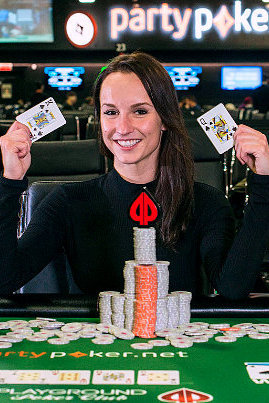
Ema Zajmovic became the first-ever female champion of an open WPT main event in 2017
Darren Elias kept the history-making streak alive in the next WPT event. He won the WPT Fallsview Poker Classic $5,000 CAD main event for his third WPT title, which saw him enter a five-way tie for the record of most wins on the tour. The WPT closed out the winter months with the L.A. Poker Classic $10,000 main event. Daniel Strelitz outlasted a field of 521 players to win his first WPT title and the top prize of $1,001,110.
Spring
The 2017 WPT Bay 101 Shooting Star main event drew 806 entries, the largest turnout ever for the event. Sam Panzica came out on top with the $1,373,000 top prize. The three-stop “California Swing” of the WPT that began with the LAPC came to a close with Michael Del Vecchio winning the WPT Rolling Thunder, defeating Sorel Mizzi heads-up to win $284,638.
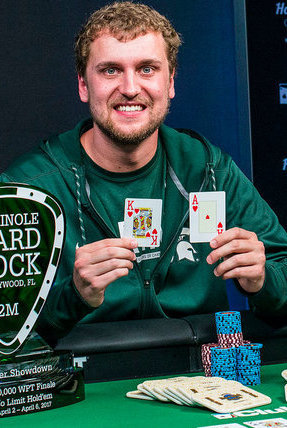
2017 WPT Seminole Hard Rock Poker Finale champion Ryan Riess
Daniel Weinman took down the second annual WPT Tournament of Champions for a $381,500 payday, putting an end to the tour’s 15th season. Weinman won his way into the event by taking down a WPT title earlier in the season and was part of a 66-player field that included his fellow season 15 winners and the champions from previous season who were able to buy-in, rake-free, for $15,000. The event also had $100,000 added to the prize pool and plenty of added bonuses, like the 2018 Audi S5 coupe Weinman was awarded as the champion.
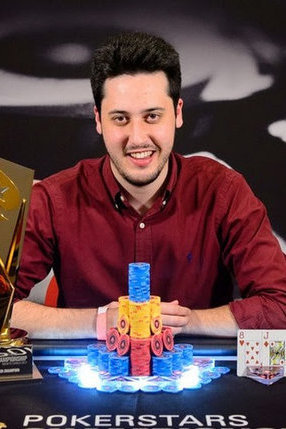
Spanish rising star Adrian Mateos
Just days later Adrian Mateos outlasted 64 entries to win the €50,000 super high roller. For the win he earned €908,000. This was only the third largest score of Mateos career, which is somewhat incredible considering that he was only 22 years old at the time. The young Spanish tournament star was only getting started with this win, so expect to hear more about him in the recap of the second half of the year.
Raffaele Sorrentino closed out the PSC Monte Carlo festival by topping the 727-entry field in the €5,300 main event to win €466,000.
Summer
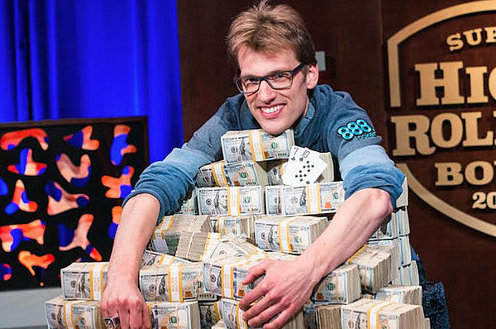
Christoph Vogelsang and his $6 million top prize
With that, the 2017 WSOP got underway. From May 31 through July 20 the Rio All-Suite Hotel & Casino hosted 74 bracelet events, with 120,995 total entries setting a new record for attendance. Over the course of the series $231,010,874 in prize money was awarded, the most in WSOP history.
Several of the biggest names in the game won bracelets this summer, including Liv Boeree and Igor Kurganov who combined to win the $10,000 tag-team no-limit hold’em event, Jesse Martin ($2,500 mixed triple draw lowball), Abe Mosseri ($10,000 Omaha eight-or-better), Ben Yu ($10,000 deuce-to-seven triple draw), Joe McKeehen ($10,000 limit hold’em), John Monnette ($10,000 no-limit deuce-to-seven single draw), Frank Kassella ($1,500 no-limit deuce-to-seven single draw), Ben Zamani ($1,500 Omaha eight-or-better) and Upeshka De Silva ($3,000 no-limit hold’em shootout).
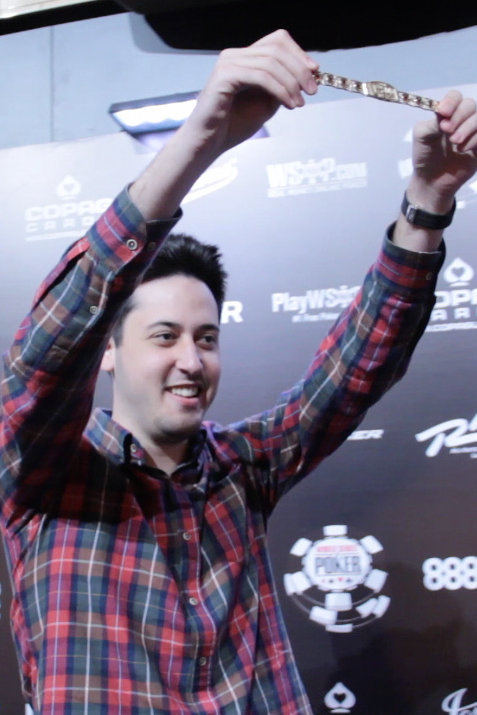
Adrian Mateos made history as the youngest player to win three bracelets
Mohsin Charania also earned a rare distinction this summer. He took down a $1,500 no-limit hold’em to win his first bracelet and complete poker’s triple crown, having now won main event titles on the World Poker Tour, the European Poker Tour and a bracelet at the WSOP.
Several other notable players also won their first bracelets, including Chris Moorman ($3,000 six-max no-limit hold’em), James Obst ($10,000 razz), Max Silver ($3,000 limit hold’em six-max), Chris Klodnicki ($1,500 no-limit hold’em), Bryce Yockey ($10,000 pot-limit Omaha eight-or-better), Tom Cannuli ($3,333 online no-limit hold’em), and Nipun Java, who won two bracelets this summer in the $1,000 tag-team no–limit hold’em event (with teammate Aditya Sushant) and the $1,000 online no-limit hold’em event.
The 2017 series hosted three high roller tournaments. Elior Sion took down the $50,000 Poker Players Championship, winning $1,395,767 and his first bracelet. The second high roller event was the $25,000 pot-limit Omaha tournament, which James Calderaro won for his first bracelet and $1,289,074. The $111,111 One Drop High Roller attracted a massive field of 130 entries. Doug Polk emerged victorious to capture the $3,686,865 first-place prize and his third bracelet.

2017 WSOP main event champion Scott Blumstein
In August the Seminole Hard Rock Poker Open series ended in a climax that saw over $7 million in guaranteed prize money awarded across five events that all finished on the same day. The marquee tournament was the $5,250 no-limit hold’em main event, which drew 887 entries. Martin Koslov came out on top to win $754,083.
The 2017 World Poker Tour Legends of Poker rounded out the summer. Art Papazyan defeated Phil Hellmuth heads-up to deny the all-time bracelet leader his first WPT title. Papazyan earned $668,692 after overcoming the 763-entry field.
Fall
Autumn kicked off with a brand new high roller series, the Poker Masters. The series of five super high rollers awarded a champion’s purple jacket to the player with the most in cashes. The jacket went to Steffen Sontheimer, who won two of the five tournaments, cashing for $2,733,000 over the course of the week.
Art Papazyan won his second World Poker Tour title of the year by taking down the WPT Maryland Live! main event for $389,405.

Chris Ferguson captured his sixth WSOP gold bracelet
Niall Farrell completed poker’s triple crown by winning his first bracelet in the €25,000 high roller event.
Dominik Nitsche won $4,049,782 and his fourth gold bracelet by outlasting 132 entries in the €111,111 One Drop High Roller event. The €10,000 main event drew 529 entries, with Marti Roca De Torres earning $1,301,815 as the eventual winner.

Sam Greenwood
The final WPT event of the year was the Five Diamond World Poker Classic at Bellagio in Las Vegas. The tournament drew a record field of 812 entries. Incredibly 2016 runner-up finisher Ryan Tosoc was able to improve on his previous finish and come out on top, earning $1,958,065 for the win.
There is a look at the most impactful poker tournaments that took place in 2017. Poker is now a global game, with huge events taking place essentially non-stop throughout the year and around the world. Make sure to stay tuned to CardPlayer.com throughout 2018 as we bring you continuing coverage of the biggest and best poker tournaments around the world.
Features
The Inside Straight
Strategies & Analysis
Commentaries & Personalities